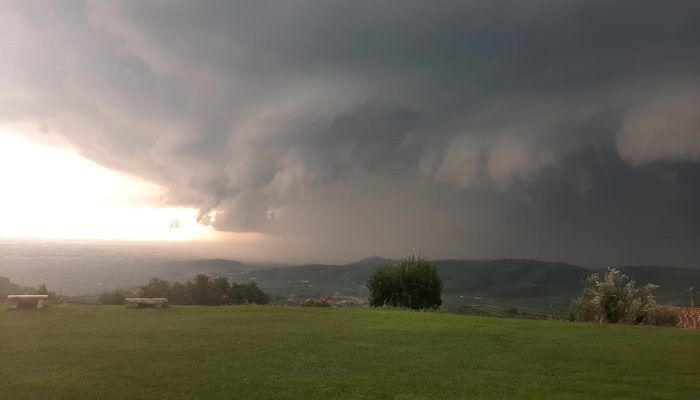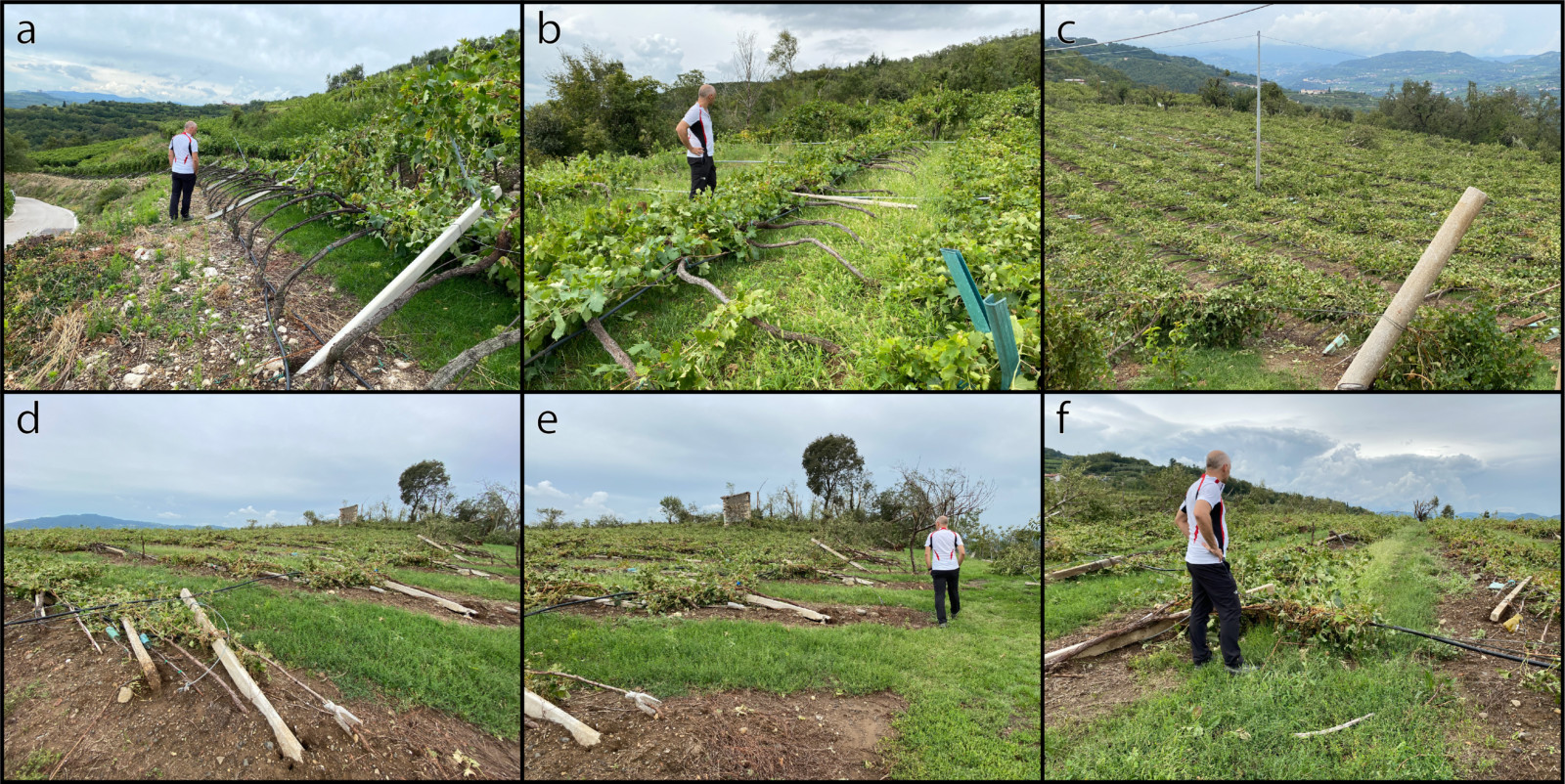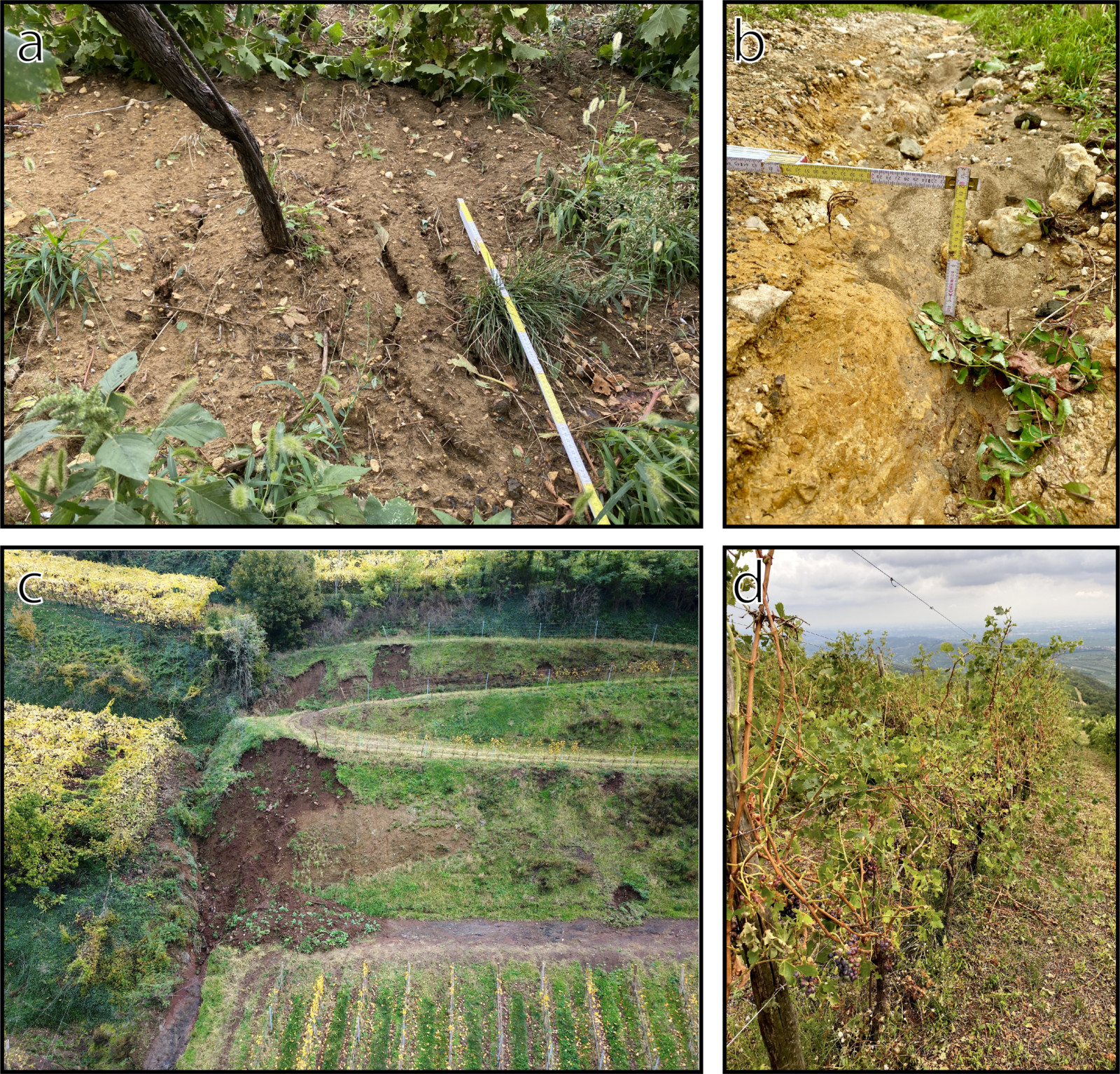
In the afternoon of August 29, 2020, an intense supercell, which is a thunderstorm characterized by the presence of a deep, persistently rotating updraft, affected the province of Verona in the north of Italy (Figure 1). It was not the first event of this kind; several other events, including tornado episodes, had already occurred during summer 2020.
Here the video of the downburst recorded during the event of August 29, 2020, in Soave hills (north-eastern Italy; video credit: Alberto Coffele; Coffele Estate Wine Farm).
Intense downburst events: a new threat for vineyards?
That afternoon I was in my home office in Padova, located 100 km far from Verona. I was aware of the meteorological conditions of those days but did not realize what was really happening. Opening Facebook I saw some shocking pictures posted by Coffele family, located in Soave traditional vineyards (recognized as one of the FAO Globally Important Agricultural Heritage Systems GIAHS) showing many fallen trees due to the intense wind. The place is exactly where my research group is conducting field research activities for monitoring soil erosion under different agriculture practices and testing nature-based solutions to mitigate it. Together with Dr Eugenio Straffelini, we took immediate action and organized a field trip in our study areas on Monday, August 31.
The aim of the field trip was to make an accurate post-event assessment and to map possible slope failures. Due to the severity of the storm, our first thoughts went to the activation of shallow landslides or a massive quantity of soil eroded by rainfall and surface runoff. Indeed, according to literature, a significant threat for vineyards, especially those located in steep-slope agricultural landscapes, is soil erosion [1]. However, once on the site, we immediately realized that soil erosion was not the major issue there. Of course, some areas were affected by rill erosion (Figure 3, photo a) and developing gullies along the rural roads (Figure 3, photo b), but these were limited. The most significant damage we saw was hectares of vineyards destroyed because of the strong wind generated by a very intense downburst episode (Figure 2).
According to farmers, similar destruction for vineyards due to wind, and with this impact, is quite rare. Nevertheless, the Veneto region was already affected by another massive windstorm event in October 2018: the Vaia storm. It caused severe damage to coniferous and mixed forests located mainly in mountainous areas quantified as more than 8 million cubic meters of standing trees destroyed as reported in the Vaia-FRONT report [2]. But in that case, the location and landscape were different, and only mountainous areas were affected. During the survey of August 31, 2020, we reached both the villages of Soave and Montecchia di Crosara, and the view was the same: total destruction of vineyards.

Fig. 2 – Effect of the downburst of August 29, 2020, on the Soave vineyards (Photo credit: E. Straffelini and P. Tarolli)
Similar episodes have probably already occurred in other regions of Italy and abroad. However, the intensity and extent of this event, and also the sequence of supercells that affected the north of Italy during summer 2020, is posing a real question. Will this be the new normal for the future? Specifically, if climate change makes the occurrence of extreme wind events such as intense downbursts a new normality, then it will represent a serious threat to viticulture, as it is for coniferous forests (such as the Vaia storm example).
Local authorities and policymakers at regional, but also at the EU level, need to be prepared with specific subsidies, able to support structural measures (for example, more stable poles) for mitigating the effect of such phenomena. It would be strategic to plan a series of investments in new research fronts to better understand their spatial and temporal evolution in steep agricultural landscapes, in addition to their frequency. It will be essential to create shared projects between the academic world, local farms, research centres and all other stakeholders, to join forces and expertise to tackle a new and potentially destructive issue. On the other hand, insurance companies need to be prepared with precise and flexible guidelines to deal with downburst impacts in vineyards. Indeed, farmers are usually covered by insurance against weather events; however, these are mainly related to hailstorms and not to downburst effects.
Major hazards in vineyard landscapes
But downburst events are only the latest hazard threatening vineyards. The complex morphology that characterizes steep-slope vineyards makes these areas intrinsically susceptible to hydrogeological instability [3]. One of the main threats is soil loss due to surface erosion while more severe mass movements could also be activated, for example, due to extreme rainfall events, and the presence of rural roads (Figure 3, photo c). Another issue, for vineyards on terraced hillsides, is drystone wall collapse. If a terrace system is not adequately maintained or correctly designed, local instability problems may occur (such as gully erosion that can evolve as a landslide) creating hazards for settlements and cultivations.

Fig. 3 – Illustrations of some significant threats for a vineyard. (a) erosion (such as rill), (b) erosion along a preferential flow path induced by a rural road, (c) shallow landslides, (d) hailstorm damages. (Photo credit: a, b, d Paolo Tarolli; c UAV survey by Cambisol).
Globally, it has been projected that during the 21st century, the frequency of intense meteorological events is likely to increase with high probability [4]. For example, the north of Italy, an economically important region for wine production, would expect an increase of extreme rainfall events by the end of this century [5, 6], a trend already observed for the past century [7]. Rainfall is capable of inducing soil erosion both through the erosive effect of raindrops and runoff [8, 9, 10]. Therefore, it is crucial to understand the evolution of intensity and duration of extreme events. When talking about extreme meteorological events, we cannot avoid talking about hailstorms (Figure 3, photo d), seen as a classic hazard with high potential impacts in grapevine cultivation systems. And, it is usually well incorporated in insurance coverages or tackled with anti-hail nets. Severe heatwaves during summer and more extended periods of drought are also hazards not to underestimate [11]. Let’s take the example of the heatwave event of summer 2019, where vineyards of the south of France were significantly damaged [12]. Lastly, frost episodes during early spring can also impact a grapevine, especially after warm winter and early vegetative period.
Steep-slope viticulture: historical heritage and cultural ecosystem services to be protected from the increasing of natural hazards
Agricultural landscapes cultivated in hilly and mountainous areas can represent the historical heritage and cultural ecosystem services in some regions [3]. Some of these sites are already listed in the UNESCO World Heritage List, but also on the Food and Agriculture Organization (FAO). The recognized value of traditional rural landscapes has led, for example, FAO to launch the Globally Important Agricultural Heritage Systems (GIAHS) programme, to protect, preserve and manage traditional agricultural knowledge and the landscapes in which they develop [13]. For example, the site where the episode of August 29 occurred, is part of such a programme to protect the traditional hillside viticulture of Soave wine, which has been practised through a sustainable management system that promotes the uniqueness of the landscape. Here, the so-called ‘heroic viticulture’ system survives. Within this system, vines are grown on steep terraced slopes that are designed and constructed according to traditional techniques. This traditional management practice is, however, very fragile. Steep terraces represent an important heritage from the landscape, historical, economic, and cultural point of view. At the same time, they are intrinsically fragile and susceptible to hydrogeological risk, as mentioned before. Such areas need to be adapted to climate change adopting a series of sustainable strategies with the purpose to preserve the ecosystems but also tradition and people.
Looking at the literature and farmers associations technical reports, one can easily feel that the climatic impact on viticulture is generally well-recognised. The indications to mitigate such criticalities are already there: the 2030 Agenda for Sustainable Development [14]. The sustainability of an agricultural practice must be assessed in the economic, social, and environmental context. It must combine the themes of productivity, profitability, resilience, land/water management, decent working conditions, and well-being, to capture its multidimensional nature. Particularly, in an articulated system such as steep-slope terraced vineyards, the sustainability of agricultural practice must manifest in all its components.
Among the applicable actions, the use of grass cover species native to the place of cultivation is strategic, as they promote the development of biodiversity and the reduction of soil erosion. Also, the promotion of new light solutions of mechanization that avoid soil compaction, even using animals, through appropriate subsidies from local governments, is highly recommended [3]. Concerning other types of problems (such as windstorms and drought), some more articulated solutions should be adopted. In the case of downburst events, new techniques for making a vineyard more stable with different anchors and stronger poles could be tested, in addition to new studies for a better understanding of the phenomena in steep-slope landscapes. In the case of drought, a more sustainable way to manage water resources and to store water on the hillslope, therefore re-establishing ecosystems and slope wetlands, should be explored. The challenges are many and diverse, as such we need more science along these lines but also the support of policymakers with clear rural development plans acted to mitigate the effects of climate change and preserve from the cultural, economic, and ecosystem point of view one of the most important sectors of agriculture.
Acknowledgement
Many thanks to Alberto Coffele, Sandro Gini, Consorzio Tutela Vini Soave e Recioto di Soave (https://www.ilsoave.com/en/) for supporting during the field research activities and providing feedback on the downburst event of August 29. Thanks also to my research assistance Dr Eugenio Straffelini who always provides supports in the field and lab. The survey was supported by the project SOiLUTION SYSTEM “Innovative solutions for soil erosion risk mitigation and a better management of vineyards in hilly and mountain landscapes”, within Programma di Sviluppo Rurale per il Veneto 2014–2020. (www.soilutionsystem.com).
References
[1] Pijl, A., Reuter, L.H.E., Quarella, E., Vogel, T.A., Tarolli, P. (2020). GIS-based soil erosion modelling under various steep-slope vineyard practices. Catena, 193, 104604. https://doi.org/10.1016/j.catena.2020.104604
[2] Vaia-FRONT (2019). https://www.tesaf.unipd.it/en/sites/tesaf.unipd.it.en/files/VAIA%20FRONT_2019_12_4_finale_1.pdf
[3] Tarolli, P., Straffelini, E. (2020). Agriculture in Hilly and Mountainous Landscapes: Threats, Monitoring and Sustainable Management. Geography and Sustainability, 1, 70–76. https://doi.org/10.1016/j.geosus.2020.03.003
[4] IPCC, 2019. Climate Change and Land – Special Report. https://www.ipcc.ch/srccl/
[5] Gao, X., Pal, J.S., Giorgi F. (2006). Projected Changes in Mean and Extreme Precipitation over the Mediterranean Region from a High Resolution Double Nested RCM Simulation. Geophysical Research Letters 33 (3). https://doi.org/10.1029/2005GL024954
[6] Zollo, A.L., Rillo, V., Bucchignani, E., Montesarchio, M., Mercogliano, P. (2016). Extreme Temperature and Precipitation Events over Italy: Assessment of High-Resolution Simulations with COSMO-CLM and Future Scenarios. International Journal of Climatology 36 (2), 987–1004. https://doi.org/10.1002/joc.4401
[7] Sofia, G., Roder, G., Dalla Fontana, G., Tarolli, P. (2017). Flood dynamics in urbanized landscapes: 100 years of climate and humans’ interaction. Scientific Reports 7, 40527. https://doi.org/10.1038/srep40527
[8] Panagos, P., Ballabio, C., Borrelli, P., et al. (2015). Rainfall erosivity in Europe. Sci. Total Environ., 511, 801-814. https://doi.org/10.1016/j.scitotenv.2015.01.008
[9] Panagos, P., Borrelli, P., Meusburger, K. et al. (2017). Global rainfall erosivity assessment based on high-temporal resolution rainfall records. Sci Rep 7, 4175. https://doi.org/10.1038/s41598-017-04282-8
[10] Zuazo, V.D., Ruiz, J.A., Raya, A.M., Tarifa, D.F. (2005). Impact of erosion in the taluses of subtropical orchard terraces. Agric. Ecosyst. Environ., 107 (2-3), 199-210. https://doi.org/10.1016/j.agee.2004.11.011
[11] Lee Harris and Giulia Petroni, Europe’s Winemakers break with tradition as temperatures rise. The Wall Street Journal (Aug 31 2019).
[12] Agence France-Presse in Paris, Extreme weather to blame as France’s wine output set to fall by 12%. The Guardian (Aug 30 2019).
[13] Food and Agricultural Organization (FAO) of the United Nations (2018). Combining agricultural biodiversity, resilient ecosystems, traditional farming practices and cultural identity (2018). http://www.fao.org/documents/card/fr/c/I9187EN
[14] United Nation 2015. Transforming our world: the 2030 Agenda for Sustainable Development – A/RES/70/1. https://sustainabledevelopment.un.org/post2015/transformingourworld

Lia
Wow, It is such an important and realist report bring awareness towards climatic change.
Federico Preti
New challenges: always ready …